|
95 Years of Kakori Train Dacoity:
Remembering its Forgotten Heroes and Their Continuing Relevance
Prabal Saran Agarwal & Anu Panchal
On 5th August, PM Modi attended the bhoomi pujan of the proposed Ram Mandir at Ayodhya which is being built at the very site of Babri Masjid demolition in 1992. Ironically, not very far from Ayodhya is the Faizabad central jail where around a century ago, a Muslim revolutionary freedom fighter, Ashfaqullah Khan was executed by the British government. His sacrifice and his poetry greatly inspired the Indian youth at that time and for a moment the tense communal atmosphere of early 1920s gave way to a united struggle against British imperialism. Few days before his execution, Ashfaq wrote these more relevant than ever lines from the condemned cell:
Sunaye gam ki kise kahani, humein to apne sata rahein hain,
Hamesha subahosham dil par, sitam ke khanjar chala rahe hain.
Na koi English, na koi German, na koi Russian, no koi Turki,
Mitane wale hain apne Hindi, jo aaj humko mita rahe hain.
(Who should we share our grief with? Our own people have turned against us,
They are piercing our heart with dagger day and night.
Neither English, nor German, Neither Russian, nor Turks,
It is our own fellow countrymen who are destroying us.)
Ashfaq and his comrades were sentenced to death by the British raj because of the daring act which they organized exactly 95 years ago from today i.e. the historic Kakori train dacoity. On 9th August 1925, ten armed revolutionaries of the underground organization, ‘Hindustan Republican Association’ (HRA), looted the government treasury by stopping a passenger train between Kakori and Lucknow station in UP. The ten daredevils who participated in the action were-Ram Prasad Bismil, Ashfaqullah Khan, Rajendranath Lahiri, Shachindranath Bakshi, Manmathnath Gupta, Chandrashekhar Azad, Mukundilal Gupta, Keshav Chakravarti, Murari Sharma and Banwari Lal (who later became government approver). While Bismil, Ashfaq and Azad became legends over time, the rest of the seven revolutionaries have been largely forgotten. This article is an attempt to provide some details about these lesser known freedom fighters who were in no way less important than their more famous comrades.
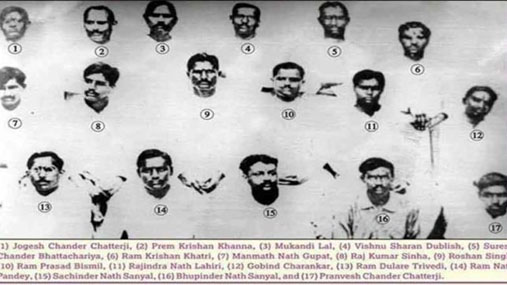
Rajendra Lahiri: Bhagat Singh’s favourite Kakori hero
Lahiri was one of the four revolutionaries hanged for Kakori dacoity. He was born in Pabna district of Bengal in 1901 but soon his family migrated to Banaras. As he grew up into a patriotic young man, he became the Banaras incharge of the HRA. After Kakori incident, he went to Calcutta to learn the art of bomb-making from Bengal revolutionaries but was arrested by the police. In the trial that followed, he was awarded capital punishment. Mysteriously, Lahiri was hanged 2 days before his other comrades on 17 December, 1927. Three days before his execution, Lahiri stoically wrote in a letter,
“What is Death? It is nothing but opposite of life. Why should we fear it? It is as natural as sunrise and sunset. If it is true that some events change the course of history, we hope that our sacrifices will not go in vain.”
Lahiri’s sacrifice did not go in vain, indeed. The powerful organization which he built in Banaras was of great help to the revolutionary cause. Although a religious man, Bhagat Singh notes that Lahiri was most well-versed with socialist ideology among the Kakori martyrs and hence his personal favourite.
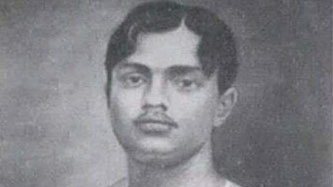
Rajendra Lahiri
Mukundi Lal: Unwept, Unsung
This Kakori hero remained largely unknown in independent India. Born in 1891 in a wealthy Vaishya family of Auraiya in U.P., Lal’s favourite hobby was body building and wrestling. In 1915, he came into contact with a charismatic government school teacher of his tehsil, Gendalal Dixit, and joined his anti-British secret society, Matrivedi. The society conducted many daring robberies at the homes of wealthy zamindars and moneylenders to raise money for the armed revolution. When Dixit and Lal were planning to assassinate the collectors and superintendants of twelve districts of U.P. on a single day, a police informer got them arrested and they were put under trial in Mainpuri. While Dixit escaped from jail, Lal was sentenced to seven years of imprisonment. He faced lots of physical torture in jail but as soon as he got released, he again became active in the anticolonial struggle. Subsequently, he was awarded life imprisonment in the Kakori conspiracy case. Lal and his comrades went on a historic hunger strike in Bareilly central jail which won several rights for the political prisoners. After Independence, Lal faced lots of difficulties as all his wealth had been confiscated by the British government due to his revolutionary activities. He did manual labour at various places to earn money and passed away in 1972, unnoticed and unsung.
The indomitable Shachindranath Bakshi
Bakshi and Ashfaq could not be caught by the police for around two years after the Kakori action. When finally they were arrested, they were brought to Lucknow central jail to identify each other. First they assumed that they do not know each other and made formal conversation so that it cannot be used against them in the court. But as soon as they shook hands, the two friends could not control their emotions and took each other into arms with tears flowing from their eyes. The jail staff was very happy and called it ‘Ram-Bharat milap’. This was the secular spirit of our young revolutionaries in 1920s!
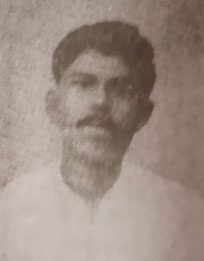
Very rare photo of Shachindranath Bakshi
Born in Banaras in 1900, Bakshi established a number of physical training clubs in the city to prepare youth against the British Raj. Later he joined the HRA and was made its Lucknow and Jhansi incharge. Subsequently, he was sentenced to life imprisonment in the Kakori supplementary case. He was released in 1937 when he and his comrades undertook a historic 47-day hunger strike in Naini central jail for the release of all political prisoners. Earlier, the Kakori prisoners had also organized a 53-day hunger strike in Bareilly jail in which Bakshi had played a leading role. After his release, Bakshi participated in the struggle for zamindari abolition but the Congress remained indecisive on this issue. Bakshi remained active in politics for many years even after 1947. In 1969, he even became MLA from Banaras.
Manmathnath Gupta, the fearless writer
Gupta was the most passionate, fearless and well-read among Kakori heroes. He very narrowly escaped death penalty due to his young age and after release from jail, went on to become a committed Marxist writer and produced a number of books on national and international issues, novels and short stories. Born in a family of patriots in 1907, he enthusiastically participated in Gandhi’s Non-Cooperation movement as a teenager. He took admission in the nationalist institution, Kashi Vidyapith but after the withdrawal of the movement by Gandhi, he became active in HRA. As an amazing polemicist, Gupta wrote a number of letters to Gandhi arguing his case for armed revolution to which the latter publicly replied in his newspaper ‘Young India’. This dialogue put both revolutionaries’ and Gandhi’s ideology in front of the masses.
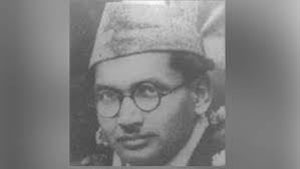
Manmath Nath Gupta
After getting released from jail in 1937, Gupta wrote his magnum opus The History of Indian Revolutionary Movement which is an invaluable work for both scholars and lay readers. His autobiography They Lived Dangerously is also a very moving and brutally honest account of our national liberation movement.
Kakori money brought mausers from Germany
Not much is known about the other two heroes of the Kakori action—Murari Sharma and Keshav Chakravarti as they were never caught by the police. Murari Sharma’s real name was Murari Lal Gupta and he belonged to Shahjahanpur district of U.P. His son Damodar Swarup grew up as a fiery poet known as ‘Vidrohi’. Gupta lived an underground life for many years after the Kakori dacoity. He died a natural death in 1982. His friends inform that he never sat on a rickshaw as he argued that it was against the dignity of labour.
Unfortunately, the name of Keshav Chakravarti has been lately used by Hindutva propagandists to serve their own vested interests. Hence Keshav Chakravarti has been ‘identified’ as Keshav Baliram Hedgewar, the founder of RSS, by a Sangh-backed writer M.L. Verma ‘Krant’! In his book on the history of revolutionary movement, released by Atal Bihari Vajpayee and published by the right-wing group Praveen Prakashan, he claims that after participating in Kakori robbery in August 1925, Chakravarti who was none other than Hedgewar, escaped to Nagpur where he founded RSS in October month of the same year. Whereas the truth is that HRA sent the real Keshav Chakravarti to Germany to procure mauser pistols for the party for which the Kakori action had been organized. Chakravarti was successful in his mission and one of the mauser pistols which he brought back became the favourite of Chandrashekhar Azad. Interestingly, he himself gave this entire account in one of the special editions of RSS’s mouthpiece, Panchjanya which was also corroborated by his comrades. Yet, RSS-backed writers have not shied away from shamelessly falsifying the history of this great freedom fighter.
Sword with ideas on its edge
The heroes of Kakori dacoity stood for a democratic, secular and socialist India as is clear from the manifesto of their party called ‘The Revolutionary’ issued on 1st January, 1925. They declared “Chaos is necessary to the birth of a new star.” They argued that British “have no justification to rule over India except the justification of sword and therefore the revolutionary party had taken to the sword. But the sword of the revolutionary party bears ideas at its edge.”
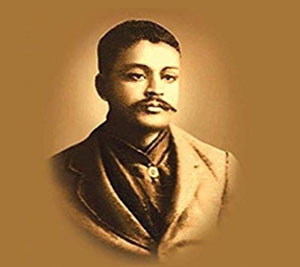
Sachindranath Sanyal, author of The Revolutionary and founder of HRA
They aimed at establishment of a federal Republic of United States of India by an organized and armed revolution based on the principles of universal suffrage and abolition of all conditions which make the exploitation of man by man possible. HRA manifesto called for nationalization of railways, transportation, communication, mines, heavy industry and right to recall elected representatives. It declared that it had international goals and it would work for global harmony on the lines of ancient seers of India and Bolsheviks of modern day Russia.
Communal disharmony was on rise in North India in 1920s and there had been several riots in districts like Kanpur which were strongholds of HRA. HRA revolutionaries openly came out against communal politics and declared that “the revolutionary party contemplates to grant whatever rights the different communities may demand, provided they do not clash with the interests of other communities and they lead ultimately to hearty and organic union in different communities in the near future.” What a mature and relevant ideological position for our times!
The selfless friendship of Kakori martyrs Bismil and Ashfaq became a symbol of Hindu-Muslim unity in riot-torn UP and changed the course of anticolonial struggle in the late 1920s.
On the question of revolutionary violence, HRA manifesto categorically announced that “the Indian revolutionaries are neither terrorists nor anarchists. They never aim at spreading anarchy in the land and therefore they can never properly be called anarchists. Terrorism is never their object and they cannot be called terrorists. They do not believe that terrorism alone can bring independence and they do not want terrorism for terrorism's sake although they may at times resort to this method as a very effective means of retaliation”, arguing, “the official terrorism is surely to be met by counter-terrorism.”
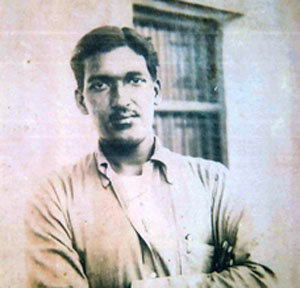
Ashfaqullah Khan
HRA’s radical vision was carried forward by Bhagat Singh and his comrades after most of its leaders were executed or imprisoned due to the Kakori Conspiracy Case. On release, most HRA leaders joined the socialist or communist movement. No doubt, their struggle against exploitation of man by man, oppression, poverty, hunger, injustice and communalism will continue to inspire the Indian masses for generations to come. In his last letter addressed to the nation before his execution, Ashfaqullah Khan wrote from Faizabad Jail,
Utho Utho So Rahe Ho Nahak Payame Bange Jaras To Sun Lo,
Badho Ki Koi Bula Raha Hai Nishane Manzil Dikha-Dikhakar.
(Rise, rise and awake and hear the trumpets of war,
March forward as we have shown you the righteous path.)
Prabal Saran Agarwal, PhD Scholar, Jawaharlal Nehru university & Anu Panchal, PhD Scholar, Delhi University
Back to Home Page
Aug 10, 2020
Prabal Agarwal prabals.007@gmail.com
Your Comment if any
|
